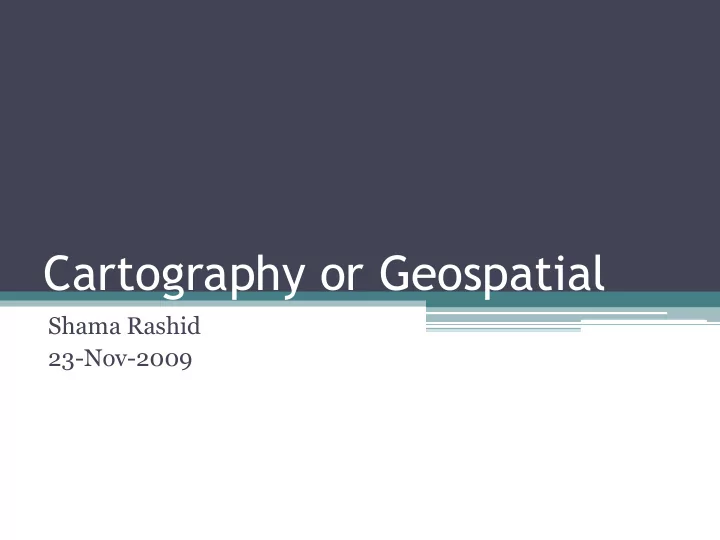

Cartography or Geospatial Shama Rashid 23-Nov-2009
The Space-Time Cube Revisited from a Geo-Visualization Perspective Menno Jan Kraak International Cartographic Conference, 2003
’60s Hägerstrand’s space-time model: • Space-Time Path(STP) – limited by capability constraints, coupling and authority constraints • Terms – stations, activity bundles, path footprint, • Space-Time Prism – Potential Path Space (PPS), PPA • Space-Time cube – 3 dimensions, geography along x-y axis, time along z axis Figure 1 : Authors day at the city of Enschede
An interactive visual environment with alternative graphics connected to the cube via multiple linked views Figure 2 : Napoleon's 1812 march into Russia
• Orienteering run, fitness run – terrain and it’s effect, reconstruct participant’s trajectory • Archaeology – spread of civilization, interesting location
Figure : Napoleon’s retreat
Pros: • Strong tool, can associate axis with other variable • Scaling along axis possible Cons: • Space and time have to be associated to two of the axis • Need additional views even for basic space concepts like distance Questions on usability aspects of the cube’s viewing environment: 1. How many views can the user handle? 2. Can multiple STPs be shown? 3. How should the interface look like?
Unfolding the Earth : Myriahedral Projections Jarke J. Van Wijk The Cartographic Journal, Feb 2008
Terms : • Myriahedron • Parallels and meridians • Graticulated mesh • Tissot indicatrix • Conformal projection • Equal area projection • terra incognita projection Factors leading to different requirements 1) intended use of the map 2) the available technology 3) the area or aspect
• Triangular faces with small area as node and edges as edge of graph G • foldout connected and can be flattened implies H f is a spanning tree • G c is a spanning tree • no fold-overs Algorithm to generate myriahedral: 1. Generate a mesh 2. Assign weights to all edges 3. Calculate a maximal spanning tree H f using Prim’s algorithm O(|E| +|V| log|V|) 4. Unfold the mesh 5. Render the unfolded mesh
a. Generate mesh lines along and perpendicular to contours of f with the algorithm of Jobard and Lefer; b. Calculate intersections of these sets of lines, and derive polygons; c. Tesselate polygons with more than four edges; and finally d. Use the standard approach to decide on folds and cuts.
Based on vector fields and tensor fields:
Azimuthal projection, random weights added, 81 920 polygons
Pros: • Methodologically interesting in Computer Science perspective • Can use different weight factors according to presentation target Cons: • fold-over rare but not restricted • Most resultant maps unusual and unusable • High computational complexity • Cuts are more disturbing than distortions to most users
Geographically Weighted Visualization: Interactive Graphics for Scale-Varying Exploratory Analysis Jason Dykes and Chris Brunsdon IEEE Transactions on Visualization and Computer Graphics, 2007
André-Michel Guerry on Moral statistics: • Dataset – related data for the departments of France in the early 19th century • View – uni-variate choropleth maps to identify trends and outliers Friendly proved some of Guerry’s hypothesis wrong using regression
x w u ( ) i i Weighted Mean, M(u, h) = w ( u ) i 2 u u i Gaussian decay function, w i (u) = exp 2 h w ( u ) i Redefining weight function as W i (u) = w ( u ) i x W ( u ) Then M(u, h) = i i Discrete set of value, probability pairs L = { x i , W i }
Take w i = w i exp ( cos( )) i Directed GW statistics at clock points to reduce computation time.
Pros: • Can compare at different scales (different values of h and θ ) • Moving window approach overcomes the abruptness of aggregation based on regional administrative hierarchy • Ability to strum the set of scalograms Cons: • Computationally expensive and hard to search for trends at large number of scales • Large number of views
Thank You
Recommend
More recommend